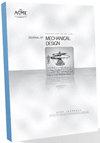Thinking Beyond the Default User: The Impact of Gender, Stereotypes, and Modality on Interpretation of User Needs
IF 3
3区 工程技术
Q2 ENGINEERING, MECHANICAL
引用次数: 0
Abstract
Throughout the mechanical design process, designers, the majority of whom are men, often fail to consider the needs of women, resulting in consequences ranging from inconvenience to increased risk of serious injury or death. Although these biases are well-studied in other fields of research, the mechanical design field lacks formal investigation into this phenomenon. In this study, engineering students (n = 300) took a survey in which they read a Persona describing a student makerspace employee and a Walkthrough describing their interaction with the makerspace while completing a project. During the Walkthrough, the user encountered various obstacles, or Pain Points. Participants were asked to recall and evaluate the Pain Points that the user encountered, then evaluated their perceptions of the makerspace and user. The independent variables under investigation were the gender of the user Persona (woman, gender-neutral, or man), Walkthrough room case (crafting or woodworking makerspace), and modality of the Persona and Walkthrough (text- /audio-based). Results showed that participants from the Text-based modality were better able to recall Pain Points compared to participants from the Audio-based modality, although the Pain Points were assessed as more severe when they impacted women users. In addition to finding that the gender of a user impacted the way a task environment was perceived, results confirmed the presence of androcentrism, or “default man” assumptions, in the way designers view end users of unknown gender. Promisingly, providing user Persona information in an audio modality eliminated this bias compared to text-based modalities.超越默认用户的思维:性别、陈规定型观念和模式对解读用户需求的影响
在整个机械设计过程中,大多数为男性的设计师往往没有考虑到女性的需求,从而导致从不便到增加严重受伤或死亡风险等后果。尽管这些偏见在其他研究领域得到了充分研究,但机械设计领域却缺乏对这一现象的正式调查。在这项研究中,工程专业的学生(n = 300)参加了一项调查,他们在调查中阅读了一份描述学生创客空间员工的 "角色 "和一份描述他们在完成一个项目时与创客空间互动的 "演练"。在演练过程中,用户遇到了各种障碍或痛点。参与者被要求回忆并评估用户遇到的痛点,然后评估他们对创客空间和用户的看法。调查的自变量包括用户角色的性别(女性、中性或男性)、"演练 "房间的情况(手工或木工创客空间)以及角色和 "演练 "的模式(基于文本/音频)。结果显示,与音频模式的参与者相比,文字模式的参与者能更好地回忆起 "痛点",尽管 "痛点 "对女性用户的影响更严重。除了发现用户的性别会影响任务环境的感知方式外,研究结果还证实了设计者在看待未知性别的终端用户时存在男性中心主义或 "默认男性 "假设。令人欣慰的是,与基于文本的模式相比,通过音频模式提供用户角色信息消除了这种偏见。
本文章由计算机程序翻译,如有差异,请以英文原文为准。
求助全文
约1分钟内获得全文
求助全文
来源期刊

Journal of Mechanical Design
工程技术-工程:机械
CiteScore
8.00
自引率
18.20%
发文量
139
审稿时长
3.9 months
期刊介绍:
The Journal of Mechanical Design (JMD) serves the broad design community as the venue for scholarly, archival research in all aspects of the design activity with emphasis on design synthesis. JMD has traditionally served the ASME Design Engineering Division and its technical committees, but it welcomes contributions from all areas of design with emphasis on synthesis. JMD communicates original contributions, primarily in the form of research articles of considerable depth, but also technical briefs, design innovation papers, book reviews, and editorials.
Scope: The Journal of Mechanical Design (JMD) serves the broad design community as the venue for scholarly, archival research in all aspects of the design activity with emphasis on design synthesis. JMD has traditionally served the ASME Design Engineering Division and its technical committees, but it welcomes contributions from all areas of design with emphasis on synthesis. JMD communicates original contributions, primarily in the form of research articles of considerable depth, but also technical briefs, design innovation papers, book reviews, and editorials.
 求助内容:
求助内容: 应助结果提醒方式:
应助结果提醒方式:


